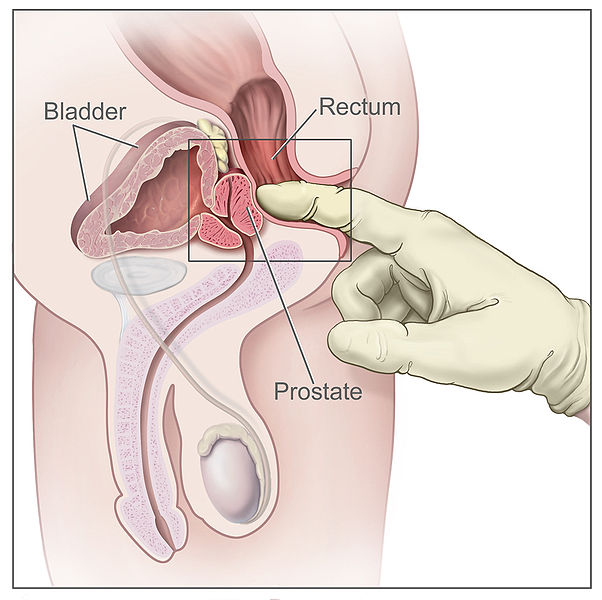Description #
This unit is intended for training of undergraduate, nursing students and first year of the core residency program in order to learn anatomy and techniques for urinary catheterization.
In this unit the cognitive understanding of the procedure includes: indications, contraindications, complications, steps of procedure, and technical skill will be performing the procedure itself.
Learning Objectives #
At the end of this unit, learners should be able to:
1. Know about the indication, contraindications of Rectal examination.
2. Performing Rectal Examination
Introduction #
Digital rectal exam #
A digital rectal exam is an internal examination of the lower rectum. The doctor or other healthcare professional uses a gloved, lubricated finger to check for abnormalities. The patient may feel mild discomfort during this test.

Indications #
This test is performed for various reasons, but is most often done as part of a routine yearly physical examination in both men and women.
This examination may be used:
- For the diagnosis of rectal tumor and other forms of cancer
- For the diagnosis of prostatic disorders, notably tumors and benign prostatic hyperplasia.
- For the diagnosis of appendicitis or other examples of an acute abdomen (i.e. acute abdominal symptoms indicating a serious underlying disease);
- For the estimation of the tonicity of the anal sphincter which may be useful in case of fecal incontinence or neurologic diseases, including traumatic spinal cord injuries.
- In females, for gynecological palpations of internal organs
- For examination of the hardness and color of the feces (i.e. in cases of constipation, and fecal impaction);
- Prior to a colonoscopy or proctoscopy.
- To evaluate hemorrhoids
- In newborns to exclude imperforate anus
Preparation for Procedure: #
The digital rectal examination (DRE, Latin palpatio per anum or PPA) is a relatively simple procedure. The patient undresses, then is placed in a position where the Anus is accessible (lying on the side, squatting on the examination table, bent over the examination table, or lying down with feet in stirrups).
If the patient is lying on their side, the physician will usually have them bring one or both legs up to their chest. If the patient bends over the examination table, the physician will have them place their elbows on the table and squat down slightly. If the patient uses the supine position, the physician will ask the patient to slide down to the end of the examination table until their buttocks are positioned just beyond the end. The patient then places their feet in the stirrups.
The physician spreads the buttocks apart and will usually examine the external area (anus and perineum) for any abnormalities such as Digital rectal exam: side view of the male reproductive and urinary anatomy, including the prostate, rectum, and bladder, hemorrhoids, lumps, or rashes. Then, as the patient strains down, the physician slips a gloved and lubricated finger into the rectum through the anus and palpates the insides for approximately sixty seconds.
Digital rectal exam: side view of the male reproductive and urinary anatomy, including the prostate, rectum, and bladder.
Complications #
The exam itself generally carries no risk, but it is possible to have a normal exam and still have an occult (unidentified/hidden) source of bleeding.
Normal Results #
The digital rectal exam is usually treated as an initial screening examination. It is usually done together with other tests to rule out abnormalities.
A “normal” finding is when the doctor does not feel any abnormalities, but this test does NOT completely rule out potential problems.
The DRE is frequently combined with an FOBT (Fecal occult blood test)), which may be useful for diagnosing the etiology of an anemia and/or confirming a gastrointestinal bleed.
The DRE is inadequate as a screening tool for colorectal cancer because it examines less than 10% of the colorectal mucosa; colonoscopy is preferred. However, it is an important part of a general examination, as many tumors or other diseases are made manifest in the distal part of the rectum.
Sometimes proctoscopy may also be part of a rectal examination.
Abnormal Results Mean #
Any bleeding in the gastrointestinal tract calls for emergency care. Patients should be evaluated in the emergency department for gastrointestinal bleeding (hemorrhage).
If tests reveal occult (hidden) blood, but there is no obvious hemorrhaging (bleeding), the patient will undergo blood tests for anemia, followed by colonoscopy.
A male patient with an enlarged or nodular prostate will undergo a blood test of prostate specific antigen (PSA test), and then possibly a prostate ultrasound and biopsy after referral to a urologist.
Rectal exam in spinal cord injuries: #
With a spinal cord injury, damage can occur to the nerves that allow a person to control bowel movements.
If the spinal cord injury is above the T-12 level, the ability to feel when the rectum is full may be lost. The anal sphincter muscle remains tight, however, the bowel movements will occur on a reflex basis. This means that when the rectum is full, the defecation reflex will occur, emptying the bowel. This type of bowel problem is called an upper motor neuron or reflex bowel. It can be managed by causing the defecation reflex to occur at a socially appropriate time and place.
A spinal cord injury below the T-12 level may damage the defecation reflex and relax the anal sphincter muscle. This is known as a lower motor neuron or flaccid bowel. Management of this type of bowel problem may require more frequent attempts to empty the bowel and bearing down or manual removal of stool.
